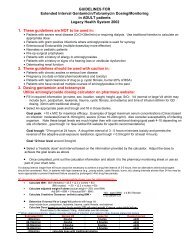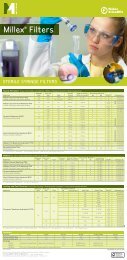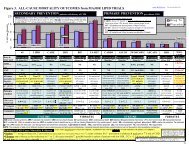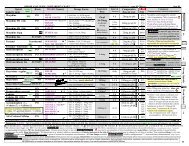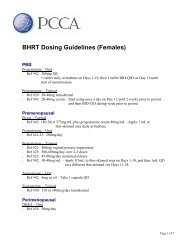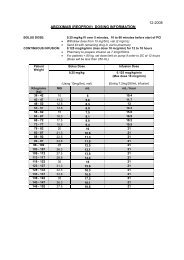Managing Hypothyroidism - DrofRx
Managing Hypothyroidism - DrofRx
Managing Hypothyroidism - DrofRx
Create successful ePaper yourself
Turn your PDF publications into a flip-book with our unique Google optimized e-Paper software.
For the use only of a Registered Medical Practitioner or a Hospital or a Laboratory<br />
<strong>Managing</strong><br />
<strong>Hypothyroidism</strong>
<strong>Hypothyroidism</strong><br />
<strong>Hypothyroidism</strong> is the most common disorder of<br />
thyroid function. It is reported to be more common<br />
in women than in men. In hypothyroidism, there is<br />
decreased production and secretion of the thyroid<br />
hormones by the thyroid gland.<br />
The principal role of the thyroid gland is to<br />
regulate tissue metabolism through production<br />
of the thyroid hormones thyroxine (T 4<br />
) and in<br />
smaller amounts tri-iodothyronine (T 3<br />
). In infants and<br />
children thyroid hormones are also needed for<br />
normal growth and development.<br />
<strong>Hypothyroidism</strong> can be classified on the basis of<br />
aetiology, age of onset and on the basis of its severity.<br />
The coming pages of this section provide detailed<br />
discussion about classification of hypothyroidism.<br />
1
Aetiology - <strong>Hypothyroidism</strong> can be classified on the<br />
basis of aetiology as primary, secondary or transient.<br />
a) Primary <strong>Hypothyroidism</strong><br />
This is hypothyroidism caused by disorders of the<br />
thyroid gland itself.<br />
Causes:<br />
l<br />
Destruction of thyroid tissue<br />
- Chronic autoimmune thyroiditis<br />
- goitrous<br />
- atrophic<br />
- Post thyroidectomy<br />
- Post radioactive iodine therapy for<br />
thyrotoxicosis<br />
- Neck radiation<br />
l<br />
l<br />
l<br />
Iodine deficiency<br />
Disorders of hormone synthesis-enzyme defects<br />
Antithyroid agents, lithium, iodine, radiocontrast<br />
dyes containing iodine, amiodarone<br />
2
The commonest cause of primary hypothyroidism in<br />
iodine-sufficient areas is chronic autoimmune<br />
thyroiditis and in iodine-deficient areas - iodine<br />
deficiency itself.<br />
b) Central / Secondary <strong>Hypothyroidism</strong><br />
Decreased thyroid hormone production and<br />
secretion by the thyroid gland due to inadequate<br />
stimulation by thyroid stimulating hormone (TSH)<br />
because of pituitary or hypothalamic disorders.<br />
Causes:<br />
- Pituitary disorders - decreased TSH<br />
- Hypothalamic disorders-decreased Thyrotropin<br />
Releasing Hormone (TRH)<br />
c) Transient <strong>Hypothyroidism</strong><br />
In this type, there is decreased thyroid hormone<br />
production and secretion for a transient period of<br />
time.<br />
3
Causes:<br />
- Silent thyroiditis<br />
- Postpartum thyroiditis<br />
- Subacute thyroiditis<br />
- After withdrawal of thyroid hormone therapy<br />
in euthyroid patients<br />
Age of onset: <strong>Hypothyroidism</strong> is also classified on<br />
the basis of age of onset as<br />
- Congenital hypothyroidism<br />
- Cretinism<br />
- Juvenile hypothyroidism<br />
- Adolescent hypothyroidism<br />
- Adult hypothyroidism.<br />
4
a) Congenital <strong>Hypothyroidism</strong><br />
Causes:<br />
Congenital <strong>Hypothyroidism</strong><br />
Transient<br />
l Iodine deficiency<br />
l Iatrogenic<br />
l Maternal/neonatal<br />
l Iodine deficiency<br />
maternal RAI therapy<br />
l TSH receptor<br />
blocking antibodies<br />
Permanent<br />
l Thyroid dysgenesis<br />
l Maternal exposure to 131 I<br />
l Dyshormonogenesis<br />
l Congenital<br />
toxoplasmosis<br />
l Hypothalamic pituitary<br />
disorders<br />
l Idiopathic<br />
This type of hypothyroidism has been in existence<br />
since antiquity. This was portrayed in the ancient<br />
sculptures of goitrous dwarfs in 400 BC in South<br />
America. It was also described in writings about<br />
goitre in ancient Roman empire in the first century.<br />
5
Congenital hypothyroidism presents at birth. It may<br />
be transient or permanent.<br />
b) Cretinism<br />
Severe iodine deficiency causing hypothyroidism<br />
in infancy and presenting as mental retardation,<br />
neurological maldevelopment and impaired<br />
growth is called cretinism. The infant having this<br />
form of hypothyroidism is called a cretin. It is<br />
rightly stated about a cretin that “What was<br />
supposed to be made into the image of God, has<br />
turned into an Imp”.<br />
- Epidemiology<br />
It is associated with endemic goitre and severe<br />
iodine deficiency.<br />
- Clinical manifestations<br />
These consist of mental deficiency, together with<br />
either of the following :<br />
i) predominant neurological syndrome - which<br />
consists of disorders of stance and gait and<br />
disorders of hearing and speech.<br />
6
ii) predominant hypothyroidism and stunted<br />
growth<br />
- Prevention<br />
Prevention of endemic cretinism with adequate<br />
correction of iodine deficiency.<br />
c) Juvenile <strong>Hypothyroidism</strong><br />
Occurs in childhood and manifests mainly as<br />
growth retardation along with other generalised<br />
features of hypothyroidism<br />
d) Adolescent <strong>Hypothyroidism</strong><br />
<strong>Hypothyroidism</strong> during adolescence presents with<br />
delayed puberty with/without short stature and<br />
menstrual irregularities in females.<br />
7
Severity : <strong>Hypothyroidism</strong> is also classified on the<br />
basis of severity as<br />
- subclinical hypothyroidism<br />
- overt or frank hypothyroidism<br />
a) Subclinical <strong>Hypothyroidism</strong><br />
In this, patients are asymptomatic and are<br />
identified in screening especially in patients at<br />
risk. Spontaneous subclinical hypothyroidism is<br />
more common in women and the incidence<br />
increases with age and is associated with the<br />
presence of antithyroid antibodies.<br />
b) Overt or Frank <strong>Hypothyroidism</strong><br />
All causes of hypothyroidism can manifest with<br />
moderate to severe symptoms and signs. However,<br />
the clinical manifestations are variable and<br />
sometimes nonspecific too.<br />
8
Risk Factors<br />
The risk of hypothyroidism does not remain the same<br />
across entire population. It changes depending upon<br />
sex, age and with presence or absence of other<br />
autoimmune disorders.<br />
The following is the list of such factors which will<br />
serve as needle of ’suspicion’ and may help in early<br />
diagnosis as well as treatment of hypothyroidism.<br />
l Past history of thyroid / pituitary /<br />
hypothalamic disease.<br />
l Family history of thyroid disease<br />
l Elderly individuals<br />
l History of hyperlipidaemia<br />
l History of depression<br />
l Obesity<br />
l History of drug intake e.g. amiodarone, iodine,<br />
lithium carbonate, para-aminosalicilic acid<br />
9
l<br />
l<br />
l<br />
l<br />
l<br />
l<br />
l<br />
History of other autoimmune diseases in the<br />
patients or in the family<br />
- insulin dependent diabetes mellitus<br />
- primary adrenal insufficiency<br />
- pernicious anaemia<br />
- vitiligo<br />
- malabsorption syndromes<br />
- collagen vascular disorders<br />
History of thyroid surgery<br />
History of RAI 131 treatment for thyrotoxicosis<br />
History of head and neck irradiation<br />
History of postpartum thyroid dysfunction<br />
Down syndrome<br />
Short stature<br />
These patients need to be screened for the presence<br />
of hypothyroidism. Clinical features discussed in<br />
the next section along with diagnostic criteria are<br />
to be utilised for confirmation of hypothyroidism.<br />
10
Clinical Features<br />
The clinical features of hypothyroidism are variable,<br />
many a times nonspecific. A high index of suspicion<br />
is necessary especially in patients who are at risk for<br />
developing hypothyroidism but still are subtle in their<br />
presentation.<br />
The clinical features vary with age of onset and<br />
severity of hypothyroidism<br />
I<br />
Clinical manifestations of hypothyroidism in<br />
general/in adults<br />
- Fatigue - Cold intolerance<br />
- Lethargy - Hoarseness of voice<br />
- Mental impairment - Dry skin<br />
- Depression - Weight gain<br />
- Goitre - Arthralgias<br />
- Non-pitting oedema<br />
- Menstrual abnormalities in women<br />
- Repeated abortions in productive age of women.<br />
11
II <strong>Hypothyroidism</strong> during adolescence<br />
- Delayed puberty<br />
- Growth retardation with delayed bone age<br />
- Galactorrhoea<br />
- Menstrual disorders in adolescent girls<br />
III <strong>Hypothyroidism</strong> during childhood<br />
- Dry skin, generalised myxedema<br />
- Constipation<br />
- Delayed dentition<br />
- Growth retardation<br />
- Delayed skeletal maturation<br />
- Myopathy<br />
- Precocious sexual development<br />
12
IV Clinical manifestations of congenital<br />
hypothyroidism<br />
l Early neonatal hypothyroidism<br />
- Prolonged icterus<br />
- Oedema<br />
- Birth weight > 4 kg<br />
- Post datism : gestation > 42 weeks<br />
- Poor feeding, hypothermia<br />
- Abdominal distension<br />
- Large posterior fontanelle<br />
l<br />
Onset during 1st month<br />
- Peripheral cyanosis/mottling<br />
- Respiratory distress<br />
- Failure to gain weight<br />
- Constipation<br />
- Decreased activity<br />
13
l<br />
Onset during first 3 months<br />
- Umbilical hernia<br />
- Constipation<br />
- Hoarse cry<br />
- Macroglossia<br />
- Generalised myxedema<br />
- Dry skin<br />
14
End<br />
Organ Impact<br />
<strong>Hypothyroidism</strong> can affect all systems of the body<br />
if not treated<br />
a) Cardiovascular system<br />
- Cardiac output is reduced but peripheral<br />
vascular resistance is increased. Diastolic<br />
blood pressure may be increased and pulse<br />
pressure decreased<br />
- Heart may be enlarged and pericardial effusion<br />
may occur<br />
- Sinus bradycardia, low amplitude ‘p’ wave ST<br />
segment alterations may be obvious on the ECG<br />
- Angina pectoris can occur rarely<br />
b) Central Nervous system<br />
- Deficiency in foetal / neonatal life leads to<br />
maldevelopment of CNS which is irreversible<br />
- All intellectual functions are decreased.<br />
Lethargy, somnolence prevail. Headaches are<br />
frequent<br />
15
c) Skeletal system<br />
- Impaired linear growth occurs<br />
- Joint pain and stiffness<br />
- In early life if hypothyroidism occurs<br />
epiphyseal dysgenesis is known to occur<br />
d) Muscular system<br />
- Stiffness and aching of muscles<br />
- Slow muscle-stretch reflexes, muscle<br />
enlargement, or atrophy<br />
e) Gastrointestinal system<br />
- Appetite is decreased<br />
- Gaseous distension of abdomen<br />
- Constipation<br />
- Rarely ascites is present<br />
- Achlorhydria and pernicious anaemia may be<br />
occasionally present<br />
16
f) Renal system<br />
- Decrease in GFR (Glomerular Filtration Rate)<br />
- Hyponatraemia<br />
g) Reproductive system<br />
- Sexual development may be arrested or it may<br />
be precocious<br />
- Decreased fertility or recurrent abortions<br />
- In woman, decreased libido and anovulation are<br />
known to occur<br />
- Menorrhagia, amenorrhoea<br />
- In man there is decreased libido or impotence<br />
and/or oligospermia<br />
h) Skin<br />
- Myxoedematous appearance (thickened<br />
features and puffiness) due to accumulation of<br />
mucopoly-saccharides on dermis and other<br />
tissues<br />
- Non-pitting oedema, localised - around the<br />
eyes, on legs/generalised.<br />
17
- Enlarged tongue<br />
- Dry, coarse icthyotic skin<br />
- Hair-dry and brittle<br />
- Loss of scalp hair and/or lateral eyebrow hair<br />
- Nails-brittle-break easily and grow slowly<br />
- In central hypothyroidism these changes are<br />
not seen.<br />
i) Haemopoietic system<br />
- Microcytic/macrocytic anaemia can occur<br />
- Capillary fragility is seen<br />
j) Pituitary and adrenal<br />
- Longstanding hypothyroidism causes increase<br />
in size of the thyroid gland<br />
- Hyperprolactinaemia can be present<br />
- Increased turnover of cortisol<br />
k) Respiratory system<br />
- Pleural effusion may occur in hypothyroidism,<br />
obstructive sleep apnoea is seen commonly<br />
18
l) Ocular System<br />
- Increased intraocular pressure<br />
m) Metabolic system<br />
- Low metabolic rate<br />
- Increased lipids cholesterol, LDL cholesterol,<br />
and triglycerides<br />
In the following section we will discuss the<br />
comorbidity associated with hypothyroidism<br />
19
Comorbidity<br />
<strong>Hypothyroidism</strong> has been frequently associated with<br />
other diseases. These co-morbid states include<br />
infertility, menstrual irregularities, Type 1 diabetes<br />
mellitus, depression, obesity, hypercholesterolaemia,<br />
etc.<br />
a) Hypercholesterolaemia<br />
Impaired thyroid function may be the cause of a<br />
hypercholesterolaemia. Clinical studies have<br />
shown that hypothyroid patients have significantly<br />
elevated serum cholesterol levels - from about<br />
30% to 50% above control values. Also increase<br />
in low density lipoprotein (LDL) cholesterol,<br />
modest fasting hypertriglycereidaemia has been<br />
observed in hypothyroid patients, particularly<br />
when they are obese.<br />
b) Diabetes Mellitus<br />
Approximately 10% of patients with Type 1<br />
diabetes mellitus develop chronic thyroiditis in<br />
20
their lifetime which may include the insidious<br />
onset of subclinical hypothyroidism. Insulin<br />
requirements may change in the presence of<br />
subclinical hypothyroidism. It is important to<br />
examine patients with diabetes for the<br />
development of a goitre.<br />
c) Infertility<br />
Some patients with infertility and menstrual<br />
irregularities have underlying subclinical or<br />
clinical hypothyroidism. In some patients with<br />
elevated TSH levels, thyroxine replacement<br />
therapy may normalize the menstrual cycle and<br />
restore normal fertility.<br />
d) Depression<br />
The diagnosis of subclinical or clinical<br />
hypothyroidism must be considered in suspected<br />
patients with depression. In fact, a small<br />
21
proportion of all patients who are depressed have<br />
primary hypothyroidism - either overt or<br />
subclinical. Also all patients on lithium therapy<br />
need periodic thyroid evaluation because lithium<br />
may induce goitre and hypothyroidism.<br />
e) Obesity<br />
Some obese patients may have hypothyroidism.<br />
Caloric needs due to hypothyroidism may be<br />
responsible for weight gain in these persons.<br />
In view of the strong association between<br />
hypothyroidism and the above comorbid states, it<br />
is advisable to look for hypothyroidism in these<br />
patients and screen accordingly through T 4<br />
and<br />
TSH testing.<br />
22
Diagnosis<br />
I Clinical Criteria<br />
- History taking to evaluate patients at risk<br />
- Symptoms/signs of thyroid hormone deficiency<br />
- Evidence of disease/previous treatment or<br />
exposure known to cause thyroid/pituitary/<br />
hypothalamic failure<br />
- Conditions associated with increased risk of<br />
chronic autoimmune thyroiditis<br />
II Laboratory Testing<br />
Specific tests<br />
Include measurement of TSH, T 4<br />
or FT 4<br />
(Free T 4<br />
), T 3<br />
or, FT 3<br />
(Free T 3<br />
)<br />
In primary hypothyroidism<br />
Decreased T 3<br />
, T 4<br />
levels with elevated TSH or<br />
Normal T 3<br />
low T 4<br />
and high TSH / Low T 3<br />
occurs<br />
in severe cases<br />
23
In subclinical hypothyroidism<br />
Normal T 3<br />
, T 4<br />
levels with elevated TSH levels<br />
In central hypothyroidism<br />
Low T 3<br />
, and T 4<br />
levels with normal or low TSH<br />
T 3<br />
, T 4<br />
, TSH Levels<br />
T 3<br />
, T 4<br />
, Normal<br />
TSH Normal<br />
T 3<br />
, T 4<br />
, Normal<br />
TSH High<br />
T 3<br />
, T 4<br />
, Low<br />
TSH High<br />
or<br />
T 3<br />
, T 4<br />
, Low<br />
TSH Normal<br />
or<br />
T 3<br />
, Normal<br />
T 4<br />
Low<br />
TSH High<br />
T 3<br />
, T 4<br />
, Low<br />
TSH Low<br />
Normal<br />
Subclinical<br />
<strong>Hypothyroidism</strong><br />
Primary<br />
<strong>Hypothyroidism</strong><br />
Central<br />
<strong>Hypothyroidism</strong><br />
In autoimmune thyroid disease causing hypothyroidism<br />
antimicrosomal antibodies are present in<br />
90% of patients.<br />
Neonatal screening for congenital hypothyroidism<br />
was introduced in 1974. This has improved the<br />
prognosis of patients with congenital<br />
hypothyroidism.<br />
Ideally, screening should be done with T 4<br />
and TSH<br />
24
levels by 4th day of neonatal life and reconfirmed by<br />
with following values<br />
FT 4<br />
< 6µg/dl and TSH > 20-40 µ I U /L<br />
In case of central hypothyroidism<br />
l<br />
l<br />
MRI brain and pituitary<br />
Other hormonal evaluation<br />
Typical reference ranges for Serum Thyroid<br />
Hormones and TSH*<br />
TSH<br />
Free T 4<br />
T 4<br />
Free T 3<br />
T 3<br />
0.3 - 4.0 mu/L<br />
0.7 - 2.1 ng/dL<br />
4.0 - 11 µg/dL<br />
0.2 - 6.5 ng/dL<br />
75 - 175 ng/dL<br />
* Reference ranges may vary according to laboratory<br />
Early diagnosis can be a major step forward in<br />
the treatment of hypothyroidism. In the next<br />
section we will discuss the treatment of<br />
hypothyroidism.<br />
25
Treatment<br />
Historically, hypothyroidism is the first endocrine<br />
disorder to be treated by supplementation of the<br />
deficient hormone.<br />
- It was treated with animal thyroid extracts in<br />
the past<br />
- This was followed by development of purified<br />
thyroid hormone preparations.<br />
Available thyroid hormone preparations are<br />
- Thyroxine sodium (T 4<br />
)<br />
- Tri-iodothyronine (T 3<br />
)<br />
- Combination of synthetic T 3<br />
and T 4<br />
- Thyroid USP (desiccated animal thyroid<br />
containing T 3<br />
and T 4<br />
in the form of<br />
thyroglobulin)<br />
The mostly widely used and preferred preparation is<br />
synthetic T 4<br />
, thyroxine sodium.<br />
26
Goal of treatment<br />
To normalise the thyroid hormone status in peripheral<br />
tissues.<br />
Initiation of therapy<br />
Initial dosage may be based on<br />
l Age of patient<br />
l Severity and duration of hypothyroidism<br />
l Presence of associated disorders like ischaemic<br />
heart disease, adrenal insufficiency<br />
Paediatric hypothyroidism<br />
l<br />
l<br />
The dosage of thyroxine sodium for paediatric<br />
hypothyroidism varies with age and body weight.<br />
Thyroxine should be given at a dose that maintains<br />
the serum total T 4<br />
or free T 4<br />
concentrations in the<br />
upper half of the normal range and serum TSH in<br />
the normal range.<br />
Thyroxine sodium therapy is usually initiated at<br />
the full replacement dose. Infants and neonates<br />
with very low or undetectable serum T 4<br />
levels<br />
27
( < 5 mcg/ dL) should start at the higher end of<br />
the dosage range (e.g. 50 mcg daily).<br />
l<br />
l<br />
A lower starting dosage (e. g. 25 mcg daily) should<br />
be considered for neonates at risk of cardiac<br />
failure, increasing every few days until a full<br />
maintenance dose is reached.<br />
In children with severe, long-standing<br />
hypothyroidism, thyroxine sodium should be<br />
initiated gradually, with an initial dose of 25 mcg<br />
for two weeks, and then increasing the dose by<br />
25 mcg every 2 to 4 weeks until the desired dose<br />
based on serum T 4<br />
and TSH levels is achieved.<br />
Age<br />
0 - 3 mos<br />
0 - 6 mos<br />
6 - 12 mos<br />
1 - 5 yrs<br />
6 - 12 yrs<br />
> 12 yrs<br />
Growth and puberty complete<br />
Daily dose per kg.<br />
Body weight*<br />
10 - 15 mcg<br />
8 - 10 mcg<br />
6 - 8 mcg<br />
5 - 6 mcg<br />
4 - 5 mcg<br />
2 - 3 mcg<br />
1.6 mcg<br />
* To be adjusted on the basis of the clinical response and laboratory test<br />
28
Adults<br />
l<br />
l<br />
l<br />
l<br />
l<br />
Young, healthy adults with no cardiac/respiratory<br />
disease are started with 1.6 mcg/kg/day of<br />
thyroxine sodium administered once daily.<br />
In elderly patients or in younger patients with<br />
cardiovascular disease dose required is lower than<br />
the usual adult dose i.e.
Dose<br />
Titration<br />
The initial dose of thyroxine sodium administered<br />
depends on patient’s age, on the severity and duration<br />
of the hypothyroidism and on the existence of the<br />
underlying cardiovascular disease.<br />
The dosage needs to be titrated against TSH levels<br />
according to individual patient’s needs.<br />
The patient should be re-evaluated and the serum<br />
TSH level should be measured in about 6- 8 weeks.<br />
The dose of thyroxine should be increased if the<br />
serum TSH concentration is elevated and decreased<br />
if it is low. Individualization and titration of proper<br />
dose is critical, aiming at normalisation of serum TSH<br />
levels.<br />
l<br />
If proper dosage adjustment is not done then<br />
under-treatment can lead to persistence and<br />
exacerbation of symptoms can lead to end<br />
organ damage, while over-treatment can lead<br />
to following side effects.<br />
30
Side effects of over-treatment with thyroxine sodium<br />
a) Children<br />
- thyrotoxicosis due to thyroid hormone<br />
- increased intracranial pressure<br />
- craniosynastosis<br />
b) Adults<br />
- accelerates bone loss in postmenopausal<br />
women<br />
- increased heart rate<br />
- increased left ventricular wall thickness and<br />
contractibility<br />
31
Drug<br />
Interactions<br />
Factors influencing the requirements of thyroxine<br />
sodium treatment<br />
I<br />
Increased requirement<br />
- Pregnancy<br />
II a) Drugs leading to decreased absorption of<br />
thyroxine<br />
- Sucralfate<br />
- Aluminium hydroxide<br />
- Ferrous sulphate<br />
b) Drugs leading to increased clearance of<br />
thyroxine<br />
- Rifampicin<br />
- Carbamazepine<br />
- Phenytoin<br />
c) Drugs that prevent conversion of T 4<br />
to T 3<br />
- Glucocorticoids<br />
- Amiodarone<br />
Depending on the above factors dose of thyroxine<br />
sodium may need adjustment.<br />
32
Monitoring<br />
and Follow up<br />
<strong>Hypothyroidism</strong> needs life long treatment & patient<br />
compliance can be an issue hence monitoring &<br />
follow up are important<br />
Adults:<br />
l<br />
Titration of dosage of thyroxine is done to<br />
maintain TSH in normal range of 0.2-5µIU/L and<br />
in cases of central hypothyroidism to maintain T 4<br />
levels in normal range (5- 13.5 µg/dl)<br />
l<br />
Follow up of these patients is done with TSH<br />
testing at 6-8 weeks intervals<br />
- In severe hypothyroid patients, older patients or<br />
in young patients with a history of a cardiovascular<br />
disease TSH testing is done at 3-6 weeks interval<br />
- In central hypothyroidism FT 4<br />
/T 4<br />
testing at 4-6<br />
week intervals<br />
33
- Once the dose is titrated and TSH /T 4<br />
maintained<br />
within normal limits, patient should be followed<br />
up at 6 months or yearly intervals<br />
Infants and neonates:<br />
l<br />
Serum T 4<br />
and TSH measurements should be<br />
evaluated at the following intervals, with<br />
subsequent dosage adjustment to normalize serum<br />
total T 4<br />
or FT 4<br />
and TSH<br />
- 2 and 4 weeks after the initiation of Thyroxine<br />
sodium treatment ;<br />
- Every 1 to 2 months during the first year of life;<br />
- Every 2 to 3 months between 1 & 3 years of age;<br />
- Every 3 to 12 months thereafter until growth is<br />
completed<br />
Evaluation at more frequent intervals is advisable<br />
when compliance is poor or abnormal values are<br />
obtained. Patient evaluation is also advisable<br />
approximately 6 to 8 weeks after any change in<br />
thyroxine sodium dose.<br />
34
Myxedema<br />
Coma<br />
Myxedema coma occurs as an extreme manifestation<br />
of severe hypothyroidism seen in patients with long<br />
standing hypothyroidism that is untreated.<br />
I<br />
Precipitating events<br />
- cold months<br />
- pulmonary events<br />
- cerebrovascular accidents<br />
- congestive heart failure<br />
- metabolic derangements<br />
- drugs - sedatives, narcotics, antidepressants<br />
II Cardinal Features<br />
- hypothermia<br />
- unconsciousness<br />
- other signs of hypothyroidism<br />
35
III Treatment<br />
- treatment of underlying cause<br />
- ventilatory support<br />
- correction of electrolyte imbalance<br />
hypothermia, hypotension<br />
- steroid treatment - injection hydrocortisone<br />
100mg, 8 hourly parenterally during initial<br />
7-10 days then tapered off<br />
- once patient is stable, consider evaluation of<br />
adrenal status<br />
Thyroid Hormone Therapy (Thyroxine Sodium)<br />
- Initial dose (loading dose), 100-500mcg<br />
followed by maintenance dose of 50-100mcg/<br />
day<br />
- Parenteral preparations if not available<br />
thyroxine tablets to be used through<br />
nasogastric tube, 500-1000 mcg initial dose<br />
followed by 50-100 mcg /day. Care to be taken<br />
if patient has ischaemic heart disease<br />
36
- Due to illness, T 4<br />
given may not be converted<br />
to T 3<br />
so some advise T 3<br />
therapy<br />
T 3<br />
treatment: quick onset of action<br />
- Bolus IV (Tri-iodothyronine) T 3<br />
20mcg,<br />
followed by 10mcg of T 3<br />
for first 24 hours and<br />
10mcg 6 hourly for next 2-3 days then oral<br />
administration is started once patient is stable.<br />
However intravenous T 3<br />
therapy is marked by<br />
large and unpredictable fluctuations in serum<br />
T 3<br />
levels and is dangerous to the cardiac status.<br />
- Some advocate combination of T 3<br />
and T 4<br />
treatment<br />
37
References:<br />
1. AACE Clinical Practice Guidelines for the Evaluation and<br />
Treatment of Hyperthyroidism and <strong>Hypothyroidism</strong> 5 January 1995.<br />
2. Polikar R, Burger AG, Scherer U, Nicod P. The thyroid and the<br />
heart. Circulation. 1993; 87 (5): 1435-1441<br />
3. Nemeroff CB. Clinical significance of psychoneuroendocrinology<br />
in psychiatry; focus on the thyroid and adrenal. J Clin Psychiatry,<br />
1989; 50 (5, Suppl) 13:20<br />
4. Vassilopoulou-Sellin R, Sellin JH. The gastrointestinal tract and<br />
liver in hypothyroidism. In Braverman LE, Utiger RD. eds. Werner<br />
and Ingbar’s The Thyroid. 7th ed. Philadelphia, PA :Lippincott -<br />
Raven Publishers; 1996:816-820<br />
5. Laycock MA, Pascuzzi RM. The neuromuscular effects of<br />
hypothyroidism. Semin Neurol. 1991; 11(3):288-294<br />
6. Moses Am, Scheinman SJ. The kidneys and electrolyte metabolism<br />
in hypothyroidism. In : Braveman LE, Utiger RD, eds. Werner and<br />
Ingbar’s The Thyroid. 7th ed. Philadelphia, PA: Lippincott-Raven<br />
Publishers; 1996:812-815<br />
7. Emerson Ch. Thyroid function and disease in the female. In : Gold<br />
JJ, Joshimovich JB, eds. Gynecologic Endocrinology. 4th ed. New<br />
York, NY: Plenum Publishing Corp; 1987:109-133<br />
8. Klausen IC, Neilsen FE, Hegedis L, Gerdes LU, Charles P,<br />
Faergeman O, Treatment of hypothyroidism reduces low-density<br />
lipoprotreins but not lipoprotein (a). Metabolism 1992; 41 (8) ;<br />
911-914.<br />
9. Bernhard JD, Freedberg IM, Vogel LN. The skin in hypothyroidism.<br />
In : Braverman LE, Utiger RD, eds. Werner and Ingbar’s The<br />
Thyroid. 7th ed. Philadelphia, PA:Lippincott-Raven Publishers;<br />
1996:792-795<br />
10. Centanni M, Cesareo R, Verallo O, et al. Reversible increase of<br />
intraocular pressure in subclinical hypothyroid patients. Eur J.<br />
Endocrinol. 1997; 136(6):595-598<br />
11. Brent GA, Larsen PR; Treatment of <strong>Hypothyroidism</strong>. The Thyroid,<br />
ed. Werner and Ingbar, 1996,884<br />
47
12. Essentials of Medical Pharmacology ed. KD Tripathi. 4th edition,<br />
1998,254<br />
13. Berger DN, Chopra IJ; <strong>Hypothyroidism</strong>. Conn’s Current Therapy,<br />
ed RE Rakel,651.<br />
14. Therapeutic Drugs. ed. Colin Dollery, 2 nd edition , 1999, 449<br />
15. Larsen PR, Ingbar SH. The thyoid gland. In: Wilson JD, Foster<br />
DW, eds. Williams Textbook of Endocrinology, 8th ed.<br />
Philadelphia, PA: WB Saunders Co; 1992:357-487.<br />
16.Utiger RD. <strong>Hypothyroidism</strong>. In: DeGroot LJ et al. eds.<br />
Endocrinology, Vol 1. 2nd ed. Philadelphia, Pa: WB Saunders Co,<br />
1989: 702-721.<br />
17.Roti E, Braverman IE. Thyroid hormone therapy: when to use it,<br />
when to avoid it. Drug Therapy. 1994;24(4): 28-35.<br />
18. Stagnaro-Green A. Postpartum thyroiditis: prevalence, aetiology,<br />
and clinical implications, Thyroid Today, 1993;16:1-11.<br />
19. Alvarez Marfany M, Roman SH, Drexler AJ, et al: Long-term<br />
prospective study of postpartum thyroid dysfunction in women with<br />
insulin dependent diabetes mellitus. J Clin Endocrinol Metab 1994;<br />
79: 10-16.<br />
20. Stockigt JR. Serum thyrotropin and thyroid hormone measurements<br />
and assessment of thyroid hormone transport, In: Braverman LE,<br />
Utiger RD, eds. Wener and Ingbar’s The Thyroid, 7th ed.<br />
Philadelphia, PA : Lippincott - Raven Publisher’s; 1996 : 377 -<br />
396.<br />
48




